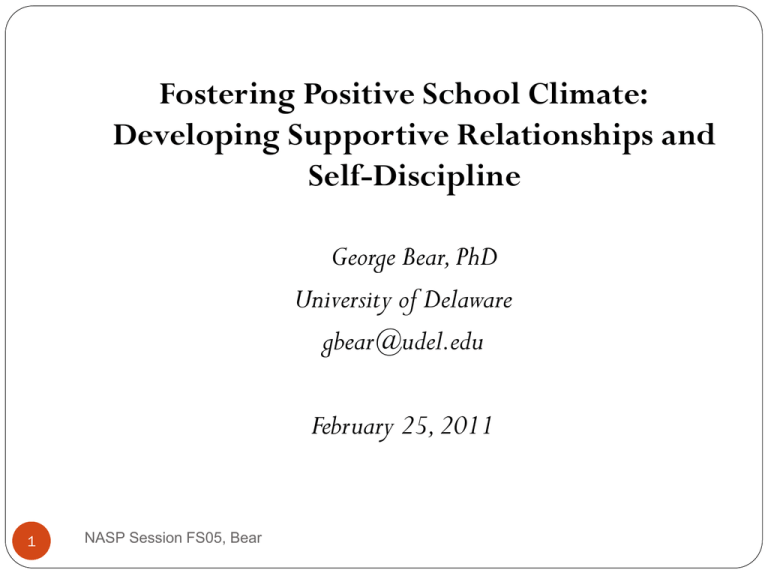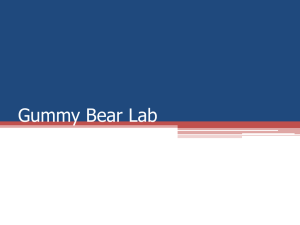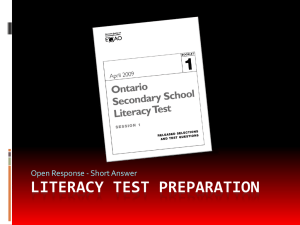- National Association of School Psychologists
advertisement

Fostering Positive School Climate: Developing Supportive Relationships and Self-Discipline George Bear, PhD University of Delaware gbear@udel.edu February 25, 2011 1 NASP Session FS05, Bear 3 Primary Goals 1. Overview of self-discipline and school climate What they are and why they are important Extent to which they are, and are not, addressed in popular approaches to school discipline 2. Review best practices for fostering both self-discipline and school climate, with an emphasis on teacher-student relationships and how students think, feel, and act. 3. Briefly discuss several chosen issues related to system change and school discipline. 2 NASP Session FS05, Bear The most important issue confronting educators and educational theorists is the choice of ends of the educational process. Without clear and rational educational goals, it becomes impossible to decide which educational programs achieve objectives of general import and which teach incidental facts and attitudes of dubious worth. Although there has been a vast amount of research comparing the effects of various educational methods and programs on various outcome measures, there has been very little empirical research designed to clarify the worth of these outcome measures themselves. —Kohlberg (1981, p. 49) 3 NASP Session FS05, Bear Past and present approaches to comprehensive school discipline: 15 to 30 years ago: Assertive Discipline/Behavior modification Values clarification Moral reasoning approach Social problem solving approach Self-esteem approach Each one was shown to be effective and ineffective, depending on one’s aim, measured outcomes, and interpretations. 4 NASP Session FS05, Bear Most Popular Approaches Now: Zero tolerance SchoolWide Positive Behavior Supports (SWPBS) Social and Emotional Learning (SEL, including character education) Each approach works, or doesn’t work, depending on one’s aim, measured outcomes, and interpretations. Conclusion: Everything works, but nothing works really well. 5 NASP Session FS05, Bear Two Traditional Aims to Discipline “teaching” that “develops self-control” and “character” “treatment” that “corrects” or ”punishes” 6 NASP Session FS05, Bear First Aim: To help create and maintain a safe and orderly learning environment. • To govern or manage behavior • More teacher-centered • Goal is more short-term Given sufficient resources, this isn’t very difficult 7 NASP Session FS05, Bear Two sides to achieving the aim of managing student behavior: Punitive Positive 8 NASP Session FS05, Bear Punitive Side Pervasive zero tolerance approach (versus reasonable policies) for correcting misbehavior, consisting of Removal from school or the classroom: Each year, about 3 million students are suspended. There are now over 12,000 alternative schools for children with behavior problems. In DE, 12.8 suspension rate versus 7.1 nationally. 9 NASP Session FS05, Bear Although controversial, each of those techniques “works” – depending on one’s aim, measured outcome, and interpretation. 10 NASP Session FS05, Bear Multiple Limitations to Punishment Among them: Effective in the short-term but not the long-term. Punishment elicits short-term compliance but does not develop long-term self-discipline. Teaches students not to get caught. Punishment fails to address the multiple factors that typically contribute to a student’s misbehavior. Used as a simple, short-term solution to a complex, long-term problem. 11 NASP Session FS05, Bear Clearly, punishment has many disadvantages, but punishment is effective (Landrum & Kauffman, 2006) and is used by the best teachers (Brophy, 1996). It would be utopian to think teachers shouldn’t use it (not corporal punishment, however). The most effective teachers (and parents) use it, although only when necessary and in combination with positive techniques. 12 NASP Session FS05, Bear Second Side USE POSITIVE BEHAVIORAL TECHNIQUES (with the Goal of Managing Student Behavior and Gaining Compliance) Too often this IS a primary goal, as reflected in both the behavioral techniques emphasized and the outcome measured (e.g., reduced suspensions or office disciplinary referrals) 13 NASP Session FS05, Bear Consistent School-wide Expectations, Direct Social Skills Training, and Positive Consequences 14 14 NASP Session FS05, Bear Bear, Oct. 11, 2007, TASP Commonly taught social skills are those of compliance, as seen in the following examples of the teaching of responsibility recommended by Horner et al. (2005, p. 369): • In the classroom: Bring books and pencils to class. Do homework. • In gym: Participate.Wear appropriate shoes. • In the hallway: Keep books, belongings, litter off floor. • On the playground: Stay within the recess area. • In the bus area: Keep your books and belongings with you. 15 NASP Session FS05, Bear Compliance also is seen in the components of the Schoolwide Evaluation Tool (SET; Sugai, Lewis-Palmer, Todd, & Horner, 2001): 1. Expectations defined. 2. Behavioral expectations taught. 3. System of rewards, consisting of an “on-going system of rewarding behavioral expectations 4. System for correcting behavior. 5. System for office disciplinary referrals. Although this four-item section is called “monitoring, evaluating, and decision making,” the only type of data addressed are office disciplinary referrals 6. System of management. 7. System of district-level support. 16 NASP Session FS05, Bear As noted by Horner (2000), “There is no difference in theory or science between positive behavior support and behavior modification. These are the same approach with different names” (p. 99). (Not all advocates of the SWPBS approach would agree with the above, and there is great variability across SWPBS schools.) 17 NASP Session FS05, Bear DIFFERENT MEANS but THE SAME AIM: TO MANAGE STUDENT BEHAVIOR? Schoolwide Discipline Code of Conduct Sentencing Manual NASP Session FS05, Bear Punitive Positive 18 It works, if one’s aim is compliance (as seen in reduced ODRs)! Important Note: The problem is not the techniques used (i.e., punishment and positive reinforcement), but (a) their short-term and teacher-centered aim – compliance (b) the types of punishment (e.g., corporal punishment, suspension/expulsion) and positive reinforcement (e.g., tangible rewards in high school) used and how they are used. 19 NASP Session FS05, Bear As noted by the Center for Mental Health in Schools (2008), too often “behavioral support” consists of a form of “social control aimed directly at reducing disruptive behavior” (p. 6-4), while doing little to improve student motivation and engagement in learning or to develop intrinsic motivation.” More recently (2011): “So: the irony is that overreliance on extrinsics to control behavior may exacerbate student problems.” (From: School Engagement, Disengagement, Learning Supports, & School Climate) 20 NASP Session FS05, Bear The greatest limitation of an over-reliance on the use of direct teaching of rules and expectations, punishment, and extrinsic rewards is not getting students to be compliant in your present, but in your absence! 21 NASP Session FS05, Bear Two Aims of School Discipline Second Aim: : To teach or develop student self-control, or self-discipline. • More student-centered • 5 Goal is more long-term NASP Session FS05, Bear Social and Emotional Learning (CASEL.org) 23 NASP Session FS05, Bear Core concepts of SEL (CASEL, 2005) Responsible decision making at school, home, and in the community Self-management of emotions and behavior Relationship skills Social awareness Self-awareness Thoughts, emotions, and behavior are viewed as equally important. 24 NASP Session FS05, Bear Alternative vision of positive school climate – one that values safety and compliance, where appropriate, but emphasizes relationships and the long-term goal of developing selfdiscipline. 25 NASP Session FS05, Bear What is Self-Discipline? Consists of each of the 5 key SEL skills, but especially: • Responsible decision making at school, home, and in the community • Self-management of emotions and behavior, and doing so under one’s own volition. Connotes the critical notion of internalization, as seen in • Committed compliance or willing compliance (versus situational or grudging compliance (Brophy, 1996; Kochanska, 2002) • Children internalize the values, standards, beliefs, and attitudes of their parents and others in society, and in the process of doing so they actively transform them and endorse them as their own. 26 NASP Session FS05, Bear Often used interchangeably with: • Autonomy • Self-determination • Responsibility • Self-regulation • Self-control Used to remind educators that there is more to school discipline than the use of discipline. LONG-TERM goal! 27 NASP Session FS05, Bear Recent meta-analysis of 213 studies of universal-level SEL programs, which included 270,034 students (Durlak, Weissberg, Dymnicki, Taylor, & Schellinger, 2011): Examined student outcomes in six areas: • social and emotional skills • attitudes toward self and others • positive social behavior • conduct problems • emotional distress • academic performance 28 NASP Session FS05, Bear Students in SEL programs had more favorable outcomes in all six areas, with effect sizes ranging from .22 to .57 for the total sample. 29 NASP Session FS05, Bear BOTH AIMS ARE IMPORTANT! But, has there been a shift in balance? Governing & Correcting Behavior 30 NASP Session FS05, Bear Developing Self-Discipline Instead of one approach or the other, it makes sense to integrate features of the two predominant approaches (Osher, Bear, Sprague, & Doyle, 2010) 1. Provides a comprehensive approach 2. Is consistent with a wealth of research on effective classroom management, as well as childrearing 3. More likely to improve school climate (and what’s most important in school climate). For these three reasons, other valued social-emotional, academic, and behavioral outcomes are more likely to be achieved. 31 NASP Session FS05, Bear 1. Provides a comprehensive approach 4 Components of Comprehensive Schoolwide Discipline (Bear, 2005, 2010) Developing Prevention Self-Discipline Correction Addressing Needs at Tiers 2 and 3 NASP Session FS05, Bear 32 Approach SWPBS SEL Developing the social and emotional competencies of self-discipline Weakness Strength Preventing behavior problems Strength (more so for immediate environment) Strength (more lasting effects) Components of Comprehensive School Discipline Correcting behavior problems (short-term goal) Strength Weakness AddressingTier 2 and 3 Needs Weakness 33 Strength NASP Session FS05, Bear Don’t confuse prevention with developing self-discipline. Prevention is much easier! 34 NASP Session FS05, Bear Second Reason for Combining techniques commonly found in SWPBS with those in SEL: It is consistent with research on effective classroom management, as well as childrearing 35 NASP Session FS05, Bear General Authoritative Approach to Discipline Supported by research on childrearing (e.g., Baumrind, 1971, 1996; Lamborn, Mounts, Steinberg, & Dornbush, 1991) Supported by research on school discipline and school climate (Brophy, 1996; Gregory, Cornell, Fan, Sheras, Shih, & Huang, 2010) Key = Authoritative (not authoritarian or permissive), which consists of a healthy blend of demandingness and responsiveness 36 NASP Session FS05, Bear Demandingness refers to the extent to which adults: • Provide close monitoring and supervision. • Present clear and consistent rules, expectations, and responsibilities. • Have clear procedures and routines. • Use discipline (including punishment) in a firm, fair, and consistent manner. • Intervene early • Provide structure Adults high in demandingness are successful in eliciting compliance (and authoritative adults do so with less use of correction!) 37 NASP Session FS05, Bear Authoritative teachers are aware of the limitations of punishment, as well as an emphasis on social skills training and clear behavioral expectations. 38 NASP Session FS05, Bear Questionable effectiveness of direct method of instruction: Law education (“preaching” or “lecturing” rules)? Social skills training (telling and showing)? 39 NASP Session FS05, Bear From: Bullis, Walker, & Sprague (2001) A Promise Unfulfilled: Social Skills Training With At-Risk and Antisocial Children and Youth, Exceptionality, 9, 67-90. “We strongly endorse this approach and believe that SST interventions should be an integral part of school and social service programs at every age level for both at-risk and antisocial children and youth. At the same time, we must acknowledge that (a) it is a gross oversimplification to assume that all at-risk and antisocial children and youth are socially inept, and (b) at-risk and antisocial youth present extreme challenges that often are resistant to even the most intense interventions.” (p. 68) 40 NASP Session FS05, Bear Hmm, then why is it too often assumed (in approaches of social control) that all children who are NOT at-risk and antisocial are socially inept and need social skills training and direct instruction? 41 NASP Session FS05, Bear Responsiveness refers to the extent adults demonstrate: Warmth Caring Respect Acceptance Support Helps motivate students to comply with teachers out of respect for the teachers rather than simply out of fear or the desire to earn tangible rewards. Critical to developing self-discipline and to school climate! 42 NASP Session FS05, Bear Not only do students like teachers who are caring, respectful, and provide emotional support, but they also show: Greater school completion (Croninger & Lee, 2001; Reschly & Christenson, 2006) Greater on-task behavior (Battistich et al., 1997; Battistich & Hom, 1997) Less cheating (Murdock, Hale, & Weber, 2001) Greater academic achievement (Gregory & Weinstein, 2004; Hamre & Pianta, 2001) Greater peer acceptance (Hughes et al., 2001) 43 NASP Session FS05, Bear Greater motivation to act responsibly and prosocially (Wentzel, 2006) Less oppositional and antisocial behavior (Bru,Stephens, & Torsheim, 2002; Meehan, Hughes, & Cavell, 2003; Murdock, 1999; Ryan & Patrick, 2001) Less bullying and victimization (Gregory et al., 2010) Less use of weapons (Henrich, Brookmeyer, & Shahar, 2005) Fewer conflicts with teachers, irrespective of degree of problem behavior (Hamre & Pianta, 2001; Hamre, Pianta, Downer, & Mashburn, 2008) Students also are more likely to internalize their teachers’ (and school’s) values (Wentzel, 1997, 2006). 44 NASP Session FS05, Bear Teacher-student relationships are particularly important for those at greatest risk for the foregoing negative outcomes, especially school disengagement and problem behaviors (Balfanz, Herzog, & MacIver, 2007; Hamre et al., 2008; Juvonen, 2007; Wentzel & Wigfield, 2007), and those lacking support from other sources, such as parents, peers, and close friends (Harter, 1999; Pianta, 1999). Improvements in positive outcomes are mediated by improvements in teacher–student relationships and the school environment (Solomon, Battistich, Watson, Schaps, & Lewis, 2000). 45 NASP Session FS05, Bear Third reason to integrate techniques: More likely to foster school climate (and those aspects of school climate that are of greatest importance). Both approaches have the goal of a positive school climate, and offer techniques for helping achieve it. Different perspectives on school climate, however: 46 SWPBS has tended to emphasize safety and organizational structure in their measures of school climate SEL has tended to emphasize relationships, sense of community and connectedness NASP Session FS05, Bear School climate should include the dimensions of demandingness (structure) and responsiveness (support) Found in the Delaware School Climate Surveys See: Bear, Gaskins, Blank, & Chen, in press (Journal of School Psychology) ww.delawarepbs.org 47 NASP Session FS05, Bear Why is school climate important? Linked to a wide range of academic, behavioral, and socio-emotional outcomes: Academic achievement (Battistich, Solomon, Kim, Watson, & Schaps, 1995; Brookover et al., 1978; Brand, Felner, Shim, Seitsinger, & Dumas, 2003; Griffith, 1999) Student academic, social, and personal attitudes and motives (Battistich, et al., 1995) Student Attendance and school avoidance (Brand, 2003; Welsh, 2000) Delinquency Relationships with School Climate are (Gottfredson, 2005; Welsh, 2000, Way, 2007) RECIPROCAL Bullying (Nansel et al., 2001) and Victimization (Gottfredson, 2005; Welsh, 2000) Attitudes toward and use of illegal substances (Brand, 2003) Depression and self-esteem (Brand et al., 2003; Way, Reddy & Rhodes, 2007) Behavior problems (Battistich & Horn, 1997; Battistich, Solomon, Kim, Watson, & Schaps, 1995; Kuperminc, Leadbeater, & Blatt, 2001; Kuperminc et al., 1997; Loukas & Robinson, 2004; Shochet, Dadds, Ham, & Montague, 2006; Welsh, 2000; Wilson, 2004) 48 NASP Session FS05, Bear National Standards for School Climate (supported by NASP and multiple other organizations) See: www.schoolclimate.org (Center for Social and Emotional Education) 49 NASP Session FS05, Bear Delaware School Climate Surveys Student Survey Teacher/Staff Survey Home Survey Part I Teacher-Student Relations Teacher-Student Relations Teacher-Student Relations Student Relations and Safety Student Relations and Safety Student Relations and Safety Fairness of Rules Rules and Expectations Rules and Expectations Teacher-Parent Relations Teacher-Parent Relations Total School Climate Total School Climate Positive Techniques Positive Techniques Positive Techniques Punitive Techniques Punitive Techniques Punitive Techniques Social-Emotional Learning SEL SEL Clarity of Expectations Total School Climate Part II Techniques (SEL) Part I: Item Examples Teacher-Student Relations • “Teachers treat students of all races with respect.” • “Adults who work in this school care about the students.” Student Relations and Safety • “Students get along with each other.” • “Students feel safe in this school.” Teacher-Parent Relations • “Teachers listen to the concerns of parents.” • “Teachers show respect towards parents.” Fairness of Rules and Clarity of Expectations • “The school rules are fair.” • “Students know they are expected to act.” 51 NASP Session FS05, Bear Part II: Item Examples Use of Positive Techniques • “Students are praised often.” • “Students are often given rewards for being good.” Use of Punitive Techniques (NOTE: A high score for this subscale is UNFAVORABLE) • “In this school students are punished a lot.” • “Students are often sent out of class for breaking rules.” Use of Social Emotional Learning (SEL) Techniques • “Students are taught to feel responsible for how they act.” • “Students are taught to understand how others think and feel.” 52 NASP Session FS05, Bear Relation of School Climate to Achievement (DSTP) and Suspensions/Expulsions 2010 Student School Climate Scores Student Survey Teacher Survey Elem Middle/High Elem Middle/High Elem Middle/High DSTP English Language Arts .64* .61* .11 -.01 .51* .46* DSTP Math .59* .58* .18 .09 .50* .45* Percentage Suspended/ Expelled -.74* -.59* -.21 .10 -.52* -.63* *p<.01. Elementary N= 69-82; Middle/High N= 37-50. Home Survey Relation of Student Perceptions of Use of Positive, Punitive, and SEL Techniques to DSTP and Suspensions/Expulsions 2010 Disciplinary Techniques: Student Survey Positive Punitive SEL Elem Middle/High Elem Middle/High Elem Middle/High DSTP English Language Arts .15 .44** -.63** -.38* .48** .54** DSTP Math .10 .36* -.58** -.41** .42** .52** Percentage Suspended/ Expelled -.28* -.29 .59** .59** -.58** -.53** *p<.05. ** p<.01. Elementary N=69-70; Middle/High N= 45. BASIC RECOMMENDED STRATEGIES: 1. Help Implement Curriculum Activities that Directly Teach Social, Emotional, and Behavioral Competencies. Packaged curriculum (e.g., for evaluations of programs see: Safe and Sound: An Educational Leader’s Guide to Evidence-Based Social and Emotional Learning (SEL) Programs. Also, see: www.CASEL.org 55 NASP Session FS05, Bear www.CHARACTER.org Infusion of curriculum lessons throughout the curriculum and everyday life of the school (e.g., class discussions, etc.) Advantages: nothing is necessarily added to the curriculum less expensive lessons often are more realistic, consisting of real-life problems and issues generlization 56 NASP Session FS05, Bear 2. Encourage Schools to Provide Multiple Opportunities for Students to Observe, Apply and Practice Social, Emotional, and Moral Competencies of Self-Discipline Provide guidance and support when students encounter situations of interpersonal conflict. For example, teach and encourage students to: • • • • 57 Use problem-solving skills Regulate emotions Think about how others might feel in a given situation Assume responsibility for their own behavior (related emotions: pride, guilt) NASP Session FS05, Bear Examples: Peer-assisted and cooperative learning (fostering student-student relations) Class meetings, student government, ClassMaps (Doll, et al, 2010 SPR, 2) School assemblies, plays, etc. Sports and extracurricular activities Service learning 58 NASP Session FS05, Bear Especially, disciplinary encounters Excellent contexts to tactfully confront social cognitions often associated with aggression (e.g., mechanisms of moral disengagement, self-centered moral reasoning, hostile attributional bias) a promote SEL competencies that are most directly related to self-discipline (e.g., empathy, social perspective taking) 59 NASP Session FS05, Bear 3. Help Implement a Broad Range of Classroom Management Strategies that Prevent Behavior Problems and Foster Self Discipline, with a Particular Emphasis on the Importance of Building and Maintaining Positive Relationships Authoritative Approach • Responsiveness • Demandingness Among multiple strategies: Strategic use of praise and rewards is very important. 60 NASP Session FS05, Bear When praise and rewards are used, they should be used strategically such that one maximizes their effectiveness in improving behavior and developing self-discipline. “Care must be taken not to over-rely on extrinsics to entice and reward because to do so may decrease intrinsic motivation” (Center for Mental Health in the Schools, 2008, p. 6-9). The Center further notes that “enhancing intrinsic motivation is a fundamental protective factor and is the key to developing resiliency.” 61 NASP Session FS05, Bear 62 NASP Session FS05, Bear 63 NASP Session FS05, Bear Can rewards undermine the aim of developing selfdiscipline? In general, research on verbal and tangible rewards indicates: • No problems when used to reward behavior of little intrinsic motivation. • Possible problems (but minor) if used to reward behavior of high intrinsic motivation, but particularly a problem if the rewards are used in a negative interpersonal context perceived to be controlling. 64 NASP Session FS05, Bear 65 • Less likely to harm intrinsic motivation (regardless if low or high) if rewards are perceived to be informational. • Perhaps greatest concern is: • What is the student learning? • Is it sufficient to change behavior or school climate? NASP Session FS05, Bear • Tangible rewards should be used only occasionally, if at all, when rewarding behavior that is intrinsically motivated (instead, rely more on praise and privileges). BUT, do not hesitate to use tangible rewards to motivate behavior that is not intrinsically motivated. This is particularly true with: 66 • Young children who have not yet learned social skills. • Others who lack social skills, or habits of good behavior. • Those whose reasoning and emotions are self-centered. • When kids simply are not self-motivated! NASP Session FS05, Bear When praise and rewards are used: Link the praiseworthy behaviors to underlying thoughts, emotions, and dispositions that that you hope to develop and to attributions of self-discipline. • feelings of pride • empathy • autonomy • responsibility • caring, kindness, trustworthiness, and so forth Most of all: Avoid teaching students that the only, or most important, reason to act in a morally and socially responsible manner is to earn rewards or to be praised. 67 NASP Session FS05, Bear Across each of the above strategies, target both risk and protective factors that research has shown to be associated with conduct problems/prosocial behavior, including the following social cognitions and emotions. Anger and its regulation (see Lochman, Powell, Clanton, & McElroy, 2006 for a review) Empathy (see Hoffman, 2000; Jolliffe & Farrington, 2004; Lovett & Sheffield, 2007 for reviews) Guilt (see Menesini & Camodeca, 2008; Frick & White, 2008; Tangney, Stuewig, & Mashek, 2007) Moral reasoning and motivation (see Arsenio, & Lemerise, 2004; Stams et al, 2006) 68 NASP Session FS05, Bear Awareness of, and sensitivity to, emotions of others and to social and moral problems (see Eisenberg, Fabes, & Spinrad, 2006) Recognition of the intention of others/hostile attributional bias (see de Castro, Veerman, Koops, Bosch, & Monshouwer, 2002, for review) Generating alternative solutions and evaluating their consequences (see Dodge, Coie, & Lynam, 2006). Mechanisms of moral disengagement (also referred to as cognitive distortions) (Bandura, 2002; Bandura, Caprara, Barbaranelli, Pastorelli, & Regalia, 2001; Weiner, 2006) Perceptions of self-efficacy (Bandura, 1997) Happiness, sense of self-worth and life satisfaction (see Gilman, Huebner, & Furlong, 2009) 69 NASP Session FS05, Bear System Change: A Few Selected Recommendations Based on Common Mistakes Seen at the State, District, and School Levels, and in Research 70 NASP Session FS05, Bear 1. Don’t Change, or ChangeVery Little, IfYou’re Already Effective! 71 NASP Session FS05, Bear 2. Determine the need for change before attempting it. 72 Closely examine existing data, including ODRs, suspensions, school climate, academic achievement, staff training, etc. Survey Strengths and Needs, as Currently Viewed by Major Stakeholders (including teachers/staff, students, home) • Open-Ended Survey • Itemized Survey NASP Session FS05, Bear Schoolwide and Classroom Strengths-and-Needs Assessment: From Schoolwide Discipline to Self-Discipline (Bear, 2010) • Adapted for DE-PBS project, aligned to Delaware’s Key Features of Positive Behavior Support • Each item is drawn from supporting research and theory • Designed to help schools assess strengths and needs: • In four areas of comprehensive schoolwide discipline (Prevention, Correction, Self-Discipline, Tier2/3 Suppors). • Plus, the areas of program development and evaluation. • Fidelity measure (outside evaluators) is also being developed that aligns with the same items. Ratings: SW = SchoolWide CR = ClassRoom 5 = Major Strength, 4 = Strength, 3 = Neither strength or weakness, 2 = Weakness, 1 = Major Weakness, DK = Don’t Know 5 = Very Important , 4 = Important, 3 = Neutral, 2 = Not Important, 1 = Not Important At All, DK = Don’t Know II.2 Self-discipline is emphasized in behavioral expectations and rules. At the schoolwide and classroom levels, the importance of self-discipline is highlighted, such as the importance of regulating and accepting responsibility for one’s actions, respecting others, helping others, and exerting one’s best effort. II.5 Lessons infused throughout the school curriculum. Lessons designed to promote the development of thoughts, feelings, and behaviors associated with responsible behavior, or self-discipline are infused in one or more areas of the curriculum. For example, curriculum activities in language arts and social studies highlight the general importance of empathy, perspective taking, and social and moral problem solving. Strength/ Weakness SW CR Importance Administer Additional Measures, as Needed, • They should assess important outcomes and might help to identify areas of specific need (e.g., School Climate) Select and implement evidence-based programs/strategies based on school, teacher, and individual student needs. • E.g., the Good Behavior Game, home-school collaboration, social perspective taking – schoolwide, one classroom, selected individuals? Consider that not only might a program not be needed, but it might actually have harmful affects. 75 NASP Session FS05, Bear 3. If change is needed, don’t tinker! :”…. simple changes may be easier to carry out, but they may not make much of a difference.”(Fullan, 2007, p. 91) 76 NASP Session FS05, Bear Tinkering = • • • • • • 77 Too little, much less work than needed Lack of fidelity of implementation Not aligning staff development to goals/objectives Not measuring outcomes Creating nothing new Not really “fixing” much NASP Session FS05, Bear 4.Take logistics very seriously ! Anticipated sources of resistance Time for staff development Funding and resources needed Time for implementation 78 NASP Session FS05, Bear 5. Be careful of bandwagons! See where they’ve been (and if others appreciated the ride) Know where they’re heading (and if its where all passengers want to go) Recognize that the ride is slow and rough – it might be worth it! Try to make it as comfortable as possible. Get along with the other passengers, including the kids. Consider other ways of getting there. If you’re doing just fine already (but not being stagnant), don’t jump aboard. Instead, celebrate where you are! 79 NASP Session FS05, Bear







